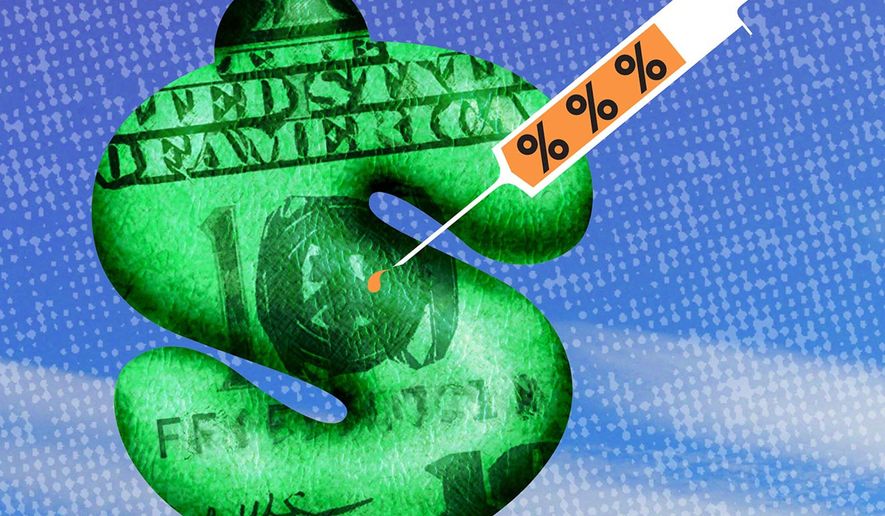OPINION:
If the economy slips into recession, you can “thank” the Federal Reserve. All around the country is the economic detritus of its monetary malfeasance.
For two years, the Fed has flooded the economy with cash. That reduced borrowing costs for Congress’ spending spree, but it also got the economy addicted to cheap credit, caused asset bubbles and ignited inflation.
At first glance, the economy seemed to be humming along, with business sales increasing and wages rising. But those are just nominal changes, meaning they’re not adjusted for price increases. Such an adjustment yields the real change, and it is not pretty.
Average weekly earnings increased 4.6% from April 2021 to April 2022 but decreased 3.4% in real terms. The latest data show consumers spent 1.1% more in March but only received 0.2% additional goods and services, while real disposable income plummeted 0.4%.
Those may sound like small numbers, but they represent an 11.4% annual inflation rate, wherein prices double in less than seven years.
And that inflation is wreaking havoc on the economy at large. The Commerce Department’s advance estimate of first-quarter growth this year showed large nominal gains while the real economy shrank. All the apparent growth was just inflation.
Similarly, the March manufacturing report from the Census Bureau showed that new orders grew nominally, but after adjusting for inflation, the real change was negative. In other words, factories had fewer new orders than the month before, but prices rose so rapidly that the total cost of those orders exceeded the previous month. Inflation has been giving the appearance of growth, but the reality is very different.
The raging inflation has caused consumers to deplete their savings and go into debt. The trillions of dollars in savings that accrued during the pandemic have been wiped out, and savings, which fell 85% over the last year, are now below pre-pandemic levels.
Large purchases, like housing, are unaffordable for many Americans. Over the last year, the typical monthly housing payment has risen 30% as inflation continues driving up home prices and higher interest rates are increasing borrowing costs.
Meanwhile, consumers are increasingly relying on credit cards to make it from paycheck to paycheck, swelling credit-card balances. In an environment of rising interest rates, that is a recipe for disaster, but it also illustrates the unsustainable nature of what the Fed hath wrought.
Having created this monetary mess, the Fed now has the choice to clean it up. Recalling that cheap credit is addictive for the economy, we must recognize that there will be — and already are — withdrawal symptoms. The prospect of raising rates just a half percentage point sent the Dow Jones Industrial Average stock index down almost 1,000 points in a day.
For context, a half-percentage-point rate hike is nowhere near extreme. The last time inflation was this high, the Fed had interest rates over 13%; today, they’re 0.25%. The Fed is laughably behind the curve. Instead of trying to catch up, the Fed is too focused on a “soft landing” — a euphemism for delaying the inevitable return to normal interest rate levels.
Higher interest rates are not a remedy to be taken lightly. They are like chemotherapy; you only take such a devastating cure when the disease is much worse. But the Fed delayed treating the cancer of inflation for so long that now the only cure will be a strong dose of chemotherapy, and the longer the Fed waits, the worse off the patient will be.
Thus, the Fed has backed itself, and America, into a corner where the only way out is pain. That may sound like a forecast from Clubber Lang, but it’s still true. If the Fed fails to wring inflation out of the economy, then the economic malaise of the first quarter will persist, and people will continue to be made poorer by the hidden tax of inflation. But if the Fed attacks inflation aggressively, as the late Fed Chair Paul Volker did, it will likely cause a recession in the short run.
Both choices involve pain, but attacking inflation lays the groundwork for a stable dollar — a necessary ingredient to long-run growth. It is much like an alcoholic who decides to quit drinking. Going “cold turkey” will have painful short-term effects but will contribute to long-term health. The economy is no different.
Having already kowtowed to left-wing talking points like “diversity” and “climate change,” it seems unlikely that the Fed is still apolitical enough to drastically increase interest rates in a midterm election year. Engineering a soft landing is an excuse for the Fed to continue the addiction, much like the alcoholic trying to ween himself off with the “hair of the dog.”
Nevertheless, the longer the Fed takes to tighten, the worse the eventual withdrawal symptoms. Biographer Ron Chernow summed up this phenomenon in “Alexander Hamilton”: “As is often the case with addictions, the fanciful notion of a gradual discontinuance only provide[s] a comforting pretext for more sustained indulgence.”
• E.J. Antoni is a research fellow for regional economics at the Heritage Foundation’s Center for Data Analysis and a senior fellow at Committee to Unleash Prosperity.




Please read our comment policy before commenting.